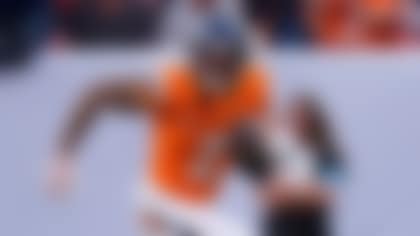Early in 2016, it was seen as a liability. Dan Quinn was brought in with a defense-first approach, but due to an infusion of youth and some injury hangups, his changes had yet to take effect on the field. Atlanta gave up 31, 28, 32 and 33 points in its first four games, but thanks to the aforementioned offensive prowess, emerged with a 3-1 mark. Come Week 5, the defense started to figure it out, shutting down Denver in a 23-16 win.
It wasn't until Week 12 when the Falcons' defense truly neared its peak. Atlanta closed the season with a string of five wins in its final six regular season games and allowed more than 20 points just twice during that stretch. That same unit then harassed Russell Wilson (three sacks, two interceptions) and Aaron Rodgers (two sacks, one interception) en route to two blowout playoff wins, the NFC title and a trip to Super Bowl LI.
Atlanta's Achilles' heel early in the season was centered on the tight end, so much so that in those first four games, tight ends were in the top two pass-catchers for each of the Falcons' opponents. Jimmy Graham gave Atlanta fits in Week 6. And in the Falcons' 29-28 loss to Kansas City, Travis Kelce went for 140 yards on eight receptions.
That game brings us to the crux of this Super Bowl preview. New England and Atlanta didn't face off in the regular season, so as we spend the days ahead of LI breaking down and overanalyzing every little bit of information available to us and drone on about legacies, we must also attempt to find a decent comparison in what has already happened on the field. That lies in Week 13's Kansas City/Atlanta showdown.
New England's best comparison on Atlanta's slate leading up to the Super Bowl is Kansas City for a few reasons:
»The Chiefs get the ball out faster than any offense in the league (Alex Smith averaged a time to throw of 2.38 seconds). New England's three quarterbacks each finished in the league's top 25 in fastest time to throw (Garoppolo: 2.43 seconds; Brissett: 2.48 seconds; Brady: 2.57 seconds), and among passers attempting at least 150 passes in the regular season, Brady finished 15th.
»Kansas City allowed 32 sacks between Smith (28 in 15 games) and backup quarterback Nick Foles (four times in three games); New England allowed 24 sacks among Brady (15 in 12 games), Garoppolo (three in six games) and Brissett (six in three games).
»Each has a receiving corps that is strongest as the sum of its parts. Both offenses boast a dynamic tight end that instantly creates mismatches. It's just that New England's weapon at the position, Rob Gronkowski, won't be playing due to injury.
»And each offense likes to play the perimeter and take advantage of playmakers getting the ball in the flats, in space. The difference between the two, though, is that New England can also go deep when it wants, something Kansas City rarely did.
The key tenets of a top-flight defense are these: rush the passer relentlessly, be fundamentally sound in tackling and cover effectively. Game plans don't stray from those focuses. But how will Atlanta attempt to stop New England's offense?
We turn to that Week 13 matchup, in which Atlanta managed to sack Smith just once (a Vic Beasley sack that forced a fumble and Chiefs turnover). The Falcons rolled almost exclusively with a single-high safety look, switching between zone and man coverage, as well as frequently using a hybrid that isolated the outside corners in man coverage with the remaining defenders dropping in zone underneath. It worked in limiting the wide receivers, but allowed for plenty of misdirection underneath to flourish over the middle of the field and in the flats, leading to Kelce's big day and multiple receptions for Tyreek Hill. Smith also had an efficient day, completing 21 of 25 passes for 270 yards and a touchdown.
Kelce even found success early against one of Atlanta's best defensive backs in Keanu Neal on this early streak that produced a touchdown a play later.
Facing a Patriots team with a viable tight end in Martellus Bennett, this could pose a major issue for the Falcons.
Scan Atlanta's defensive roster. That linebacker situation includes two rookies and a second-year pro in Beasley. It took half a season for the youngsters to get the pro game down, while Beasley showed he was ready for a breakout season, finishing as the league leader in sacks with 15.5. The latter is an asset, while the former could be perceived as a weakness. But Deion Jones has showed marked improvement late in the season and could very well be up to the task of covering Bennett.
There is reason for encouragement. In Graham's second contest against Atlanta (in the divisional round), the Falcons held him to 22 yards and a touchdown on two receptions. He was a factor early, but became irrelevant as the game progressed.
Where this game will turn will come in Atlanta's ability to pressure Brady. It's been nearly impossible for every team except Denver, which registered a stark contrast in Next Gen Stats associated with pressure, including average number of defenders in the pocket when Brady released a pass.
Compare that with this, the next closest game in terms of pressure on Brady, quantified in sacks (four):
Brady finished that contest against the Bills with a stat line of 22-of-33 passing, 315 yards and four touchdowns. His line against Denver: 16 of 32, 188 yards and a big goose egg in the touchdown category.
Cue up the film, and you'll see how the Broncos did it. Denver was rarely consistent in the defensive fronts it showed and stunts it employed, which forced Brady into quick decisions, often before he was comfortable making them, resulting in multiple incompletions. The Broncos walked up seven defenders to the line before rushing four in one instance and stunted a defensive end three gaps across the line on another play.
Denver then, inexplicably, stopped bringing the heat. Brady completed a few short passes to break up their rush, and suddenly the Broncos were reduced to base rushes with little creativity, even dropping enough defenders at one point to rush just three. As expected, Brady had plenty of time to scan the field (ban the three-man rush already) before completing a pass inside the five.
That drive ended in six for the Patriots, who went on to win 16-3. It should serve as a lesson to the Falcons, who don't have a rusher quite like Von Miller (Beasley is close, but different) and didn't mix it up much against Kansas City. But the Falcons showed in a dominant win over the Rams that, thanks to Beasley, it can still stunt and reach the quarterback with dangerous speed.
The Falcons will have to mix it up -- base rushes won't do the job against a quick-thinking Brady -- and also keep an eye on the slot man, be it Julian Edelman, who's third in the league statistically when lined up in the slot (46 percent of pass plays) with 61 grabs for 665 yards, or Chris Hogan, who caught three passes for 99 yards and a touchdown when in the same alignment in the AFC title game. That goes against relying solely on the single-high safety with outside man coverage. Therein lies the question mark: How well can Brian Poole, Atlanta's nickelback, cover a variety of receivers?
The numbers pertaining to that question ring true to the idea that Atlanta has improved late in the season. In a startling turn of events, the loss of Desmond Trufant actually made Atlanta's secondary play better. Just look at that improvement in opposing passer rating.
And finally, the X-factor in the absence of Gronkowski has been diminutive running back Dion Lewis, an excellent runner and pass-catcher out of the backfield. These passer rating charts offer a peek into what we might see on Sunday, which is a healthy dose of Lewis catching passes in the flats.
The task ahead of Atlanta is a monumental one, but then again, it's the Super Bowl. It isn't supposed to be easy. If the Falcons continue their streak of hot starts and can get a stop early, it'll go a long way to making things simpler for Atlanta's defense. If that isn't the case, we'll be in for a fireworks display even Lady Gaga might not be able to top. Buckle up.











